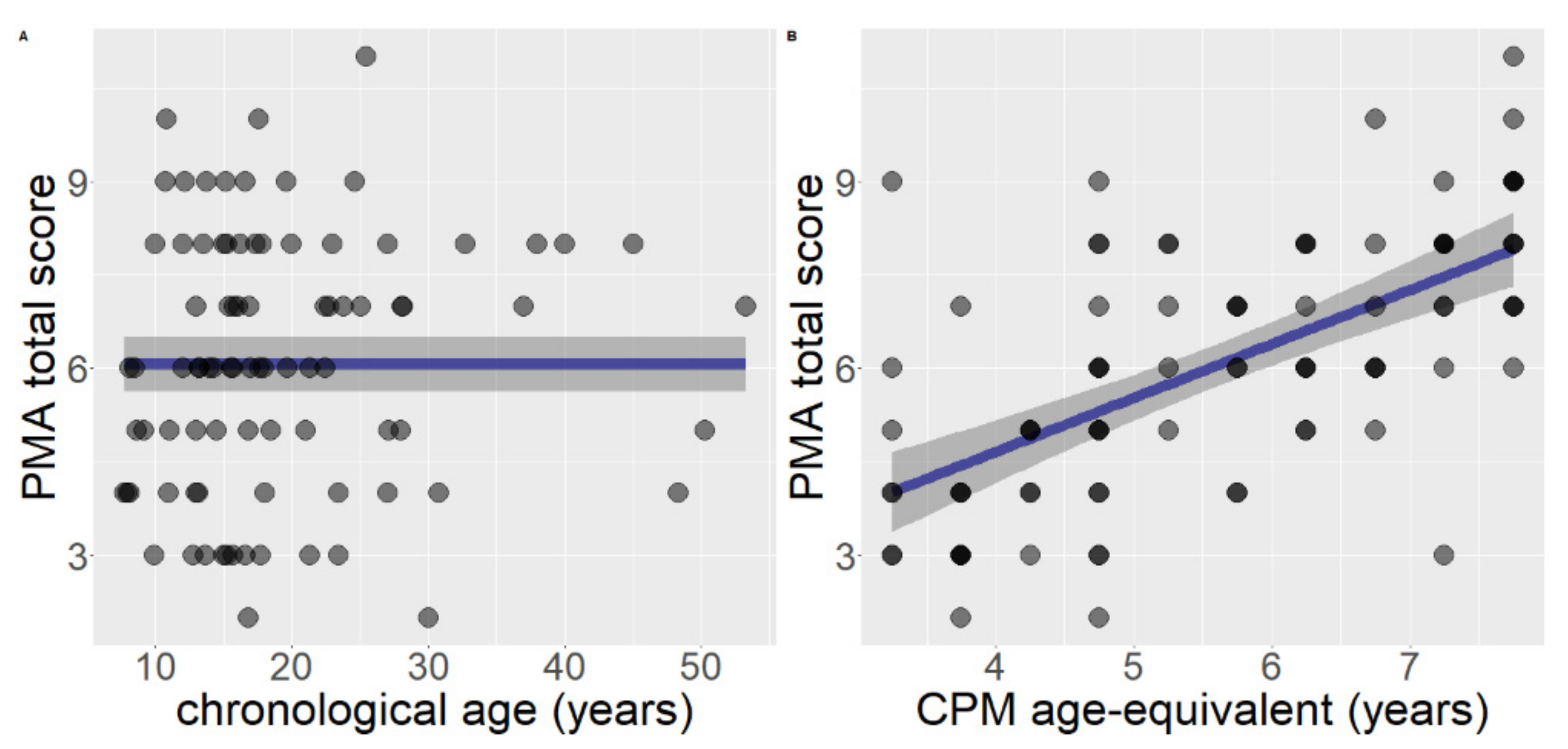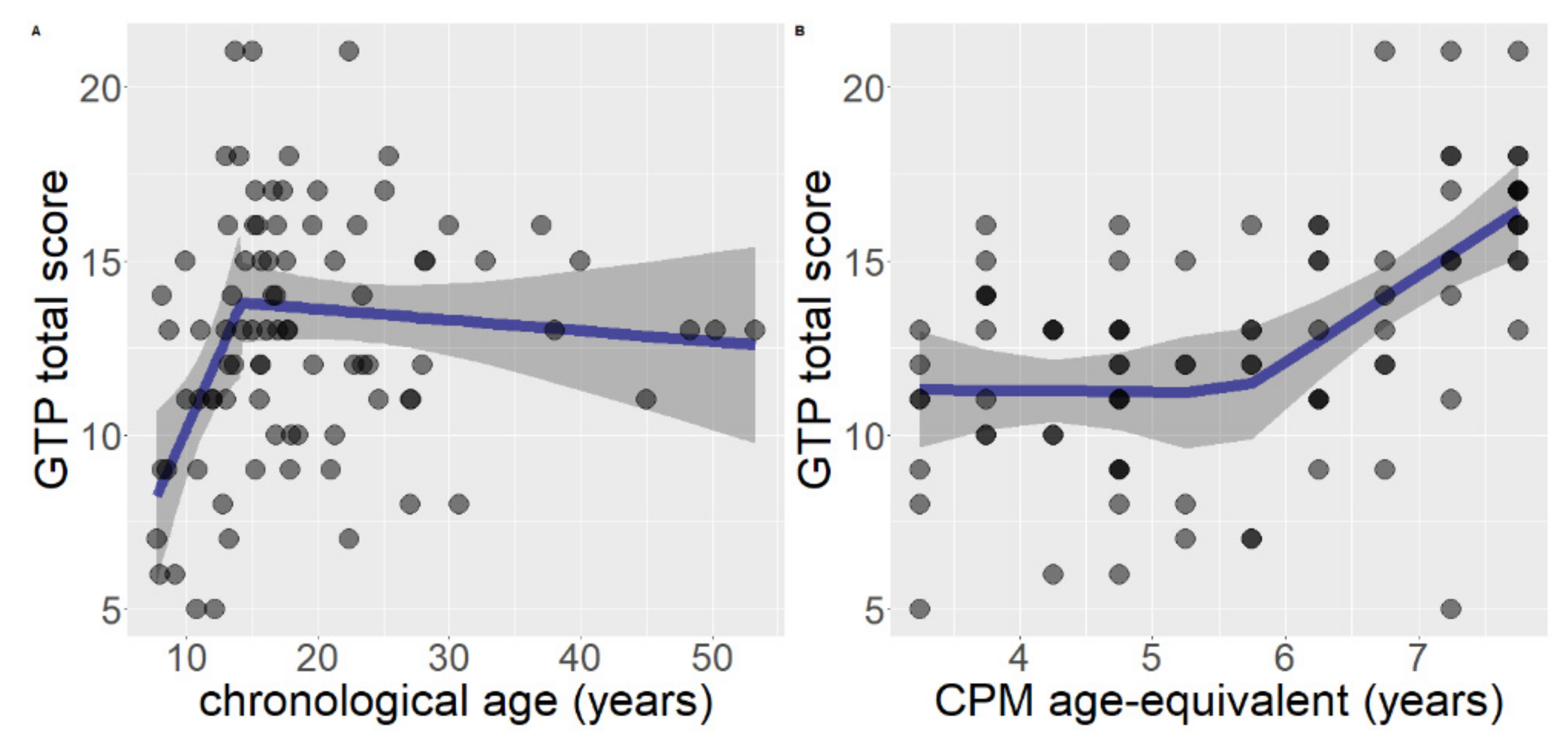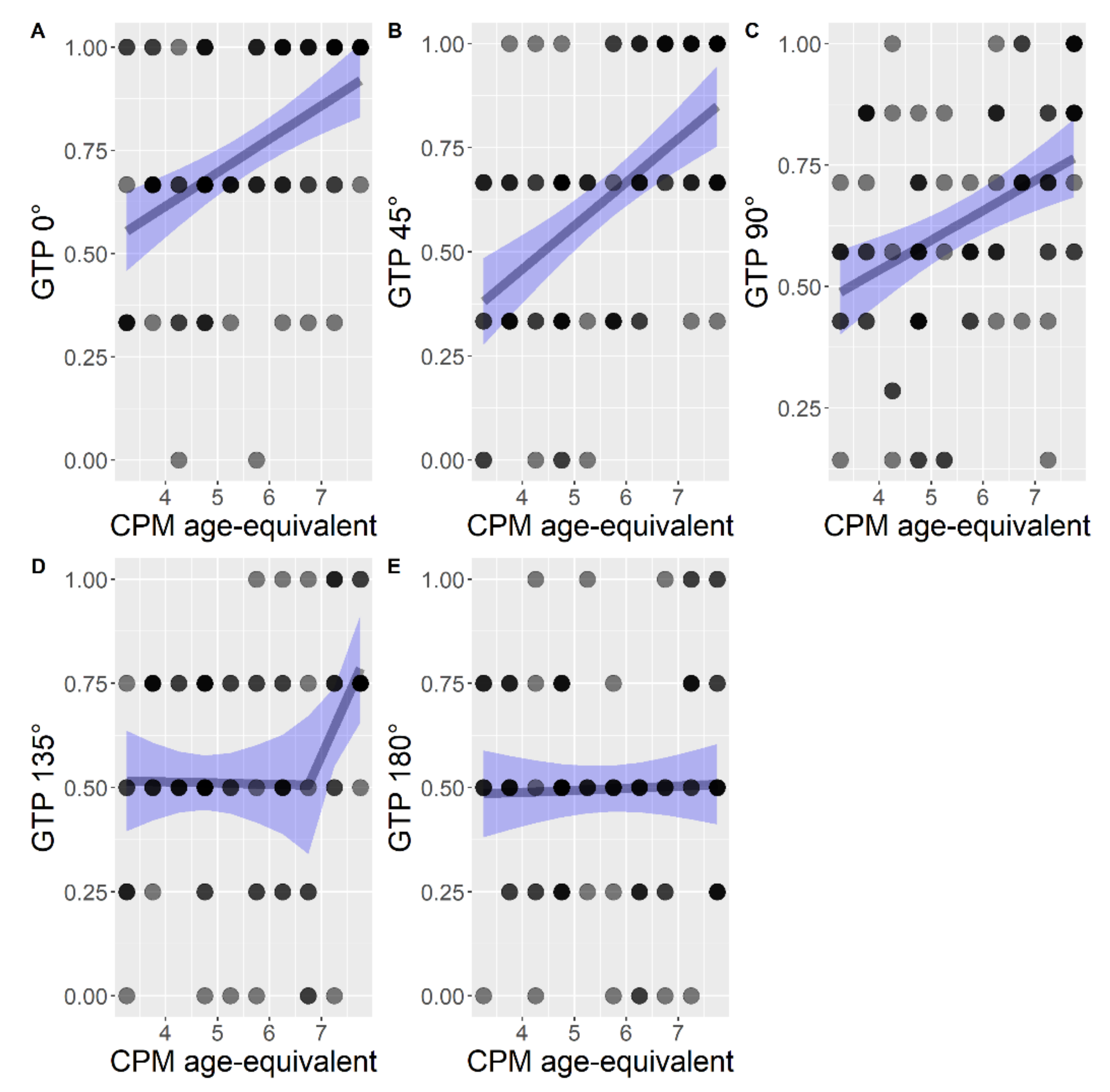Developmental Trajectories in Spatial Visualization and Mental Rotation in Individuals with Down Syndrome
Abstract
1. Introduction
1.1. Visuospatial Abilities in Down Syndrome
1.2. Visuospatial Abilities, Developmental Trajectories, and Gender Differences in TD Children
1.3. Visuospatial Abilities and Developmental Trajectories in Individuals with DS
1.4. Rationale and Aim of the Study
2. Materials and Methods
2.1. Participants
2.2. Materials
2.2.1. Visuospatial Reasoning Task. Raven’s Colored Progressive Matrices (CPM)
2.2.2. Mental Rotation Task. Ghost Picture Test (GPT)
2.2.3. Spatial Visualization Task. Primary Mental Abilities–Spatial Relations–K1 (PMA-K1)
2.3. Procedure
3. Results
3.1. Descriptive Statics
3.2. Analysis of the Developmental Trajectories
- total raw score as dependent variable, gender as covariate and age as predictor (either chronological or developmental level);
- each rotation degree. Therefore, the dependent variable was the total score for the specific rotation (0–45–90–135–180°) and the predictor was age once again, either chronological or developmental level.
3.2.1. Spatial Visualization
3.2.2. Mental Rotation
4. Discussion
5. Conclusions
Author Contributions
Funding
Institutional Review Board Statement
Informed Consent Statement
Data Availability Statement
Acknowledgments
Conflicts of Interest
References
- Lohman, D.F. Spatial Ability: A Review and Reanalysis of the Correlational Literature; Technical Report No. 8; Stanford University: Stanford, CA, USA, 1979. [Google Scholar]
- Hegarty, M.; Waller, D.A. Individual Differences in Spatial Abilities. In The Cambridge Handbook of Visuospatial Thinking; Shah, P., Miyake, A., Eds.; Cambridge University Press: Cambridge, UK, 2005; pp. 121–169. [Google Scholar] [CrossRef]
- Linn, M.C.; Petersen, A.C. Emergence and characterization of sex differences in spatial ability: A meta-analysis. Child Dev. 1985, 56, 1479–1498. [Google Scholar] [CrossRef]
- Fenner, J.; Heathcote, D.; Jerrams-Smith, J. The development of wayfinding competency: Asymmetrical effects of visuo-spatial and verbal ability. J. Environ. Psychol. 2000, 20, 165–175. [Google Scholar] [CrossRef]
- Mix, K.S.; Cheng, Y.L.; Hambrick, D.Z.; Levine, S.C.; Young, C.; Ping, R.; Konstantopoulos, S. Separate but correlated: The latent structure of space and mathematics across development. J. Exp. Psychol. Gen. 2016, 145, 1206–1227. [Google Scholar] [CrossRef] [PubMed]
- Dykens, E.M.; Hodapp, R.M.; Finucane, B.M. Genetics and Mental Retardation Syndromes: A New Look at Behavior and Interventions; Paul H Brookes Publishing: Baltimore, MD, USA, 2000. [Google Scholar]
- Kittler, P.M.; Krinsky-McHale, S.J.; Devenny, D.A. Dual-task processing as a measure of executive function: A comparison between adults with Williams and Down syndromes. Am. J. Ment. Retard. 2008, 113, 117–132. [Google Scholar] [CrossRef]
- Silverman, W. Down syndrome: Cognitive phenotype. Ment. Retard. Dev. Disabil. Res. 2007, 13, 228–236. [Google Scholar] [CrossRef]
- Yang, Y.; Conners, F.A.; Merrill, E.C. Visuo-spatial ability in individuals with Down syndrome: Is it really a strength? Res. Dev. Disabil. 2014, 35, 1473–1500. [Google Scholar] [CrossRef]
- Thomas, M.S.C.; Annaz, D.; Ansari, D.; Scerif, G.; Jarrold, C.; Karmiloff-Smith, A. Using Developmental Trajectories to Understand Developmental Disorders. J. Speech Lang. Hear. R. 2009, 52, 336–358. [Google Scholar] [CrossRef]
- Logie, R.H. Visuo-Spatial Working Memory; Psychology Press: Hove, UK, 1995. [Google Scholar]
- Ellis, N.R.; Woodley-Zanthos, P.; Dulaney, C.L. Memory for spatial location in children, adults, and mentally retarded persons. Am. J. Ment. Retard. 1989, 93, 521–526. [Google Scholar]
- Laws, G. Contributions of phonological memory, language comprehension and hearing to the expressive language of adolescents and young adults with Down syndrome. J. Child Psychol. Psychiatry 2004, 45, 1085–1095. [Google Scholar] [CrossRef] [PubMed]
- Vicari, S.; Bellucci, S.; Carlesimo, G.A. Visual and spatial long-term memory: Differential pattern of impairments in Williams and Down syndromes. Dev. Med. Child Neurol. 2005, 47, 305–311. [Google Scholar] [CrossRef]
- Lanfranchi, S.; Carretti, B.; Spanò, G.; Cornoldi, C. A specific deficit in visuospatial simultaneous working memory in Down syndrome. J. Intell. Disabil. Res. 2009, 53, 474–483. [Google Scholar] [CrossRef]
- Carretti, B.; Lanfranchi, S.; Mammarella, I.C. Spatial-simultaneous and spatial-sequential working memory in individuals with Down syndrome: The effect of configuration. Res. Dev. Disabil. 2013, 34, 669–675. [Google Scholar] [CrossRef] [PubMed]
- Lanfranchi, S.; Mammarella, I.C.; Carretti, B. Spatial-simultaneous working memory and selective interference in Down syndrome. Child Neuropsychol. 2015, 21, 481–489. [Google Scholar] [CrossRef]
- Doerr, E.; Carretti, B.; Lanfranchi, S. The working memory of individuals with Down Syndrome. In International Review of Research in Developmental Disabilities; Lanfranchi, S., Ed.; Academic Press: Cambridge, MA, USA, 2019; Volume 56, pp. 93–121. [Google Scholar] [CrossRef]
- Wechsler, D. Wechsler Intelligence Scale for Children, 4th ed.; The Psychological Corporation: San Antonio, TX, USA, 2003. [Google Scholar]
- Wechsler, D. Wechsler Adult Intelligence Scale, 4th ed.; The Psychological Corporation: San Antonio, TX, USA, 2008. [Google Scholar]
- Thurstone, L.L.; Thurstone, T.G. Examiner Manual for the SRA Primary Mental Abilities Test; Science Research Associates: Chicago, IL, USA, 1949. [Google Scholar]
- Bihrle, A.M. Visuospatial Processing in Williams and Down Syndrome. Unpublished Ph.D. Thesis, San Diego State University, San Diego, CA, USA, 1990. [Google Scholar]
- Dykens, E.M.; Rosner, B.A.; Ly, T.M. Drawings by individuals with Williams syndrome: Are people different from shapes? Am. J. Ment. Retard. 2001, 106, 94–107. [Google Scholar] [CrossRef]
- Hinnell, C.; Virji-Babul, N. Mental rotation abilities in individuals with Down syndrome—A pilot study. Downs Syndr. Res. Pract. 2004, 9, 12–16. [Google Scholar] [PubMed]
- Vicari, S.; Bellucci, S.; Carlesimo, G.A. Evidence from two genetic syndromes for the independence of spatial and visual working memory. Dev. Med. Child Neurol. 2006, 48, 126–131. [Google Scholar] [CrossRef] [PubMed]
- Meneghetti, C.; Toffalini, E.; Carretti, B.; Lanfranchi, S. Mental rotation ability and everyday-life spatial activities in individuals with Down syndrome. Res. Dev. Disabil. 2018, 72, 33–41. [Google Scholar] [CrossRef] [PubMed]
- Frick, A.; Hansen, M.A.; Newcombe, N.S. Development of mental rotation in 3-to 5-year-old children. Cogn. Dev. 2013, 28, 386–399. [Google Scholar] [CrossRef]
- Krüger, M.; Kaiser, M.; Mahler, K.; Bartels, W.; Krist, H. Analogue mental transformations in 3-year-olds: Introducing a new mental rotation paradigm suitable for young children. Infant Child Dev. 2014, 23, 123–138. [Google Scholar] [CrossRef]
- Carr, M.; Alexeev, N.; Wang, L.; Barned, N.; Horan, E.; Reed, A. The development of spatial skills in elementary school students. Child Dev. 2018, 89, 446–460. [Google Scholar] [CrossRef] [PubMed]
- Thurstone, T.G. PMA Readiness Level; Science Research: Chicago, IL, USA, 1974. [Google Scholar]
- Levy, J.U.; Levy, N. Mechanical Aptitude and Spatial Relations Tests; Thomson/Arco: Princeton, NJ, USA, 2002. [Google Scholar]
- Geer, E.A.; Quinn, J.M.; Ganley, C.M. Relations between spatial skills and math performance in elementary school children: A longitudinal investigation. Dev. Psychol. 2019, 55, 637–652. [Google Scholar] [CrossRef]
- Casey, M.B.; Dearing, E.; Vasilyeva, M.; Ganley, C.M.; Tine, M. Spatial and numerical predictors of measurement performance: The moderating effects of community income and gender. J. Educ. Psychol. 2011, 103, 296–311. [Google Scholar] [CrossRef]
- Piaget, J.; Inhelder, B. The Child’s Conception of Space; Routledge & Kegan Paul: London, UK, 1956. [Google Scholar]
- Harris, J.; Newcombe, N.S.; Hirsh-Pasek, K. A new twist on studying the development of dynamic spatial transformations: Mental paper folding in young children. Mind Brain Educ. 2013, 7, 49–55. [Google Scholar] [CrossRef]
- Burgess, N. Spatial memory: How egocentric and allocentric combine. Trends Cogn. Sci. 2006, 10, 551–557. [Google Scholar] [CrossRef] [PubMed]
- Nardini, M.; Burgess, N.; Breckenridge, K.; Atkinson, J. Differential developmental trajectories for ego-centric, environmental and intrinsic frames of reference in spatial memory. Cognition 2006, 101, 153–172. [Google Scholar] [CrossRef]
- Vasilyeva, M.; Lourenco, S.F. Development of spatial cognition. Wiley Cogn. Sci. 2012, 3, 349–362. [Google Scholar] [CrossRef] [PubMed]
- Levine, S.C.; Foley, A.; Lourenco, S.; Ehrlich, S.; Ratliff, K. Sex differences in spatial cognition: Advancing the conversation. Wiley Cogn. Sci. 2016, 7, 127–155. [Google Scholar] [CrossRef] [PubMed]
- Lauer, J.E.; Yhang, E.; Lourenco, S.F. The development of gender differences in spatial reasoning: A meta-analytic review. Psychol. Bull. 2019, 145, 537–565. [Google Scholar] [CrossRef]
- Voyer, D.; Voyer, S.; Bryden, M.P. Magnitude of sex differences in spatial abilities: A meta-analysis and consideration of critical variables. Psychol. Bull. 1995, 117, 250–270. [Google Scholar] [CrossRef]
- Levine, S.C.; Vasilyeva, M.; Lourenco, S.F.; Newcombe, N.S.; Huttenlocher, J. Socioeconomic status modifies the sex difference in spatial skill. Psychol. Sci. 2005, 16, 841–845. [Google Scholar] [CrossRef]
- Alexander, G.M.; Evardone, M. Blocks and bodies: Sex differences in a novel version of the Mental Rotations Test. Horm. Behav. 2008, 53, 177–184. [Google Scholar] [CrossRef]
- Heil, M.; Jansen-Osmann, P. Sex differences in mental rotation with polygons of different complexity: Do men utilize holistic processes whereas women prefer piecemeal ones? Q. J. Exp. Psychol. 2008, 61, 683–689. [Google Scholar] [CrossRef]
- Steele, A.; Scerif, G.; Cornish, K.; Karmiloff-Smith, A. Learning to read in Williams syndrome and Down syndrome: Syndrome-specific precursors and developmental trajectories. J. Child Psychol. Psychiatry 2013, 54, 754–762. [Google Scholar] [CrossRef]
- Arango, P.S.; Aparicio, A.; Tenorio, M. Developmental trajectories of children with Down syndrome by socio-economic status: The case of Latin America. J. Intell. Disabil. Res. 2018, 62, 759–774. [Google Scholar] [CrossRef] [PubMed]
- Carretti, B.; Meneghetti, C.; Doerr, E.; Toffalini, E.; Lanfranchi, S. Developmental trajectories of spatial working memory in Down syndrome. J. Intell. Disabil. Res. 2021. under review. [Google Scholar]
- Muggeo, V.M. Estimating regression models with unknown break-points. Stat. Med. 2003, 22, 3055–3071. [Google Scholar] [CrossRef] [PubMed]
- Belacchi, C.; Scalisi, T.G.; Cannoni, E.; Cornoldi, C. Taratura Italiana del test Matrici di Raven Forma Colore (CPM-47); Manuale; Giunti Organizzazioni Speciali: Firenze, Italy, 2008. [Google Scholar]
- Dunn, L.M.; Dunn, L.M. Peabody Picture Vocabulary Test-Revised; American Guidance Service; Incorporated: Woodland, MN, USA, 1981. [Google Scholar]
- Carney, D.P.; Henry, L.A.; Messer, D.J.; Danielsson, H.; Brown, J.H.; Rönnberg, J. Using developmental trajectories to examine verbal and visuospatial short-term memory development in children and adolescents with Williams and Down syndromes. Res. Dev. Disabil. 2013, 34, 3421–3432. [Google Scholar] [CrossRef] [PubMed]
- Roid, G.H. Stanford–Binet Intelligence Scales, 5th Edition: Examiner’s Manual; Riverside Publishing: Itasca, IL, USA, 2003. [Google Scholar]
- Purser, H.R.; Farran, E.K.; Courbois, Y.; Lemahieu, A.; Sockeel, P.; Mellier, D.; Blades, M. The development of route learning in Down syndrome, Williams syndrome and typical development: Investigations with virtual environments. Dev. Sci. 2015, 18, 599–613. [Google Scholar] [CrossRef] [PubMed]
- Raven, J.; Raven, J.C.; Court, J.H. Coloured Progressive Matrices; Oxford University Press: Oxford, UK, 1998. [Google Scholar]
- Meneghetti, C.; Toffalini, E.; Lanfranchi, S.; Roch, M.; Carretti, B. Path Learning in Individuals with Down Syndrome: The Challenge of Learning Condition and Cognitive Abilities. Front. Psychol. 2021, 12, 643702. [Google Scholar] [CrossRef]
- Meneghetti, C.; Lanfranchi, S.; Carretti, B.; Toffalini, E. Visuo-spatial knowledge acquisition in individuals with Down syndrome: The role of descriptions and sketch maps. Res. Dev. Disabil. 2017, 63, 46–58. [Google Scholar] [CrossRef] [PubMed]
- Toffalini, E.; Meneghetti, C.; Carretti, B.; Lanfranchi, S. Environment learning from virtual exploration in individuals with down syndrome: The role of perspective and sketch maps. J. Intell. Disabil. Res. 2018, 62, 30–40. [Google Scholar] [CrossRef]
- R Core Team. R: A Language and Environment for Statistical Computing; R Foundation for Statistical Computing: Vienna, Austria, 2019; Available online: http://www.r-project.org/ (accessed on 5 March 2021).
- Muggeo, V.M.R. Segmented: An R Package to Fit Regression Models with Broken-Line Relationships (R package Version 1.2-0). R News. 2008, 8, pp. 20–25. Available online: https://cran.r-project.org/doc/Rnews/ (accessed on 5 March 2021).
- Akaike, H. Information theory and an extension of the maximum likelihood principle. In Proceedings of the Second International Symposium on Information Theory; Petrov, B.N., Caski, F., Eds.; Akademiai Kiado: Budapest, Hungary, 1973; pp. 267–281. [Google Scholar]
- Bilge, A.R.; Taylor, H.A. Framing the figure: Mental rotation revisited in light of cognitive strategies. Mem. Cogn. 2017, 45, 63–80. [Google Scholar] [CrossRef] [PubMed]
- Davis, M.; Merrill, E.C.; Conners, F.A.; Roskos, B. Patterns of differences in wayfinding performance and correlations among abilities between persons with and without Down syndrome and typically developing children. Front. Psychol. 2014, 5, 1446. [Google Scholar] [CrossRef]
- Lauer, J.E.; Lourenco, S.F. Spatial processing in infancy predicts both spatial and mathematical aptitude in childhood. Psychol. Sci. 2016, 27, 1291–1298. [Google Scholar] [CrossRef] [PubMed]
- Verdine, B.N.; Golinkoff, R.M.; Hirsh-Pasek, K.; Newcombe, N.S.I. Spatial skills, their development, and their links to mathematics. Monogr. Soc. Res. Child. 2017, 82, 7–30. [Google Scholar] [CrossRef]
- Van Herwegen, J.; Ranzato, E.; Karmiloff-Smith, A.; Simms, V. The foundations of mathematical development in Williams syndrome and Down syndrome. J. Appl. Res. Intellect. Disabil. 2020, 33, 1080–1089. [Google Scholar] [CrossRef]
- Cheng, Y.L.; Mix, K.S. Spatial training improves children’s mathematics ability. J. Cogn. Dev. 2014, 15, 2–11. [Google Scholar] [CrossRef]
- Cheung, C.N.; Sung, J.Y.; Lourenco, S.F. Does training mental rotation transfer to gains in mathematical competence? Assessment of an at-home visuospatial intervention. Psychol. Res. 2019, 84, 2000–2017. [Google Scholar] [CrossRef] [PubMed]
- Lakusta, L.; Dessalegn, B.; Landau, B. Impaired geometric reorientation caused by genetic defect. Proc. Natl. Acad. Sci. USA 2010, 107, 2813–2817. [Google Scholar] [CrossRef]




| CPM | PMA-K1 | GTP | |||||||
|---|---|---|---|---|---|---|---|---|---|
| M | F | TOT | M | F | TOT | M | F | TOT | |
| Mean | 15.17 | 16.20 | 15.59 | 5.65 | 6.55 | 6.07 | 12.60 | 13.10 | 12.83 |
| SD | 4.64 | 4.86 | 4.74 | 1.95 | 2.13 | 2.07 | 3.37 | 3.75 | 3.52 |
| Max | 23 | 23 | 23 | 10 | 11 | 11 | 21 | 21 | 21 |
| Min | 7 | 7 | 7 | 2 | 2 | 2 | 6 | 5 | 5 |
Publisher’s Note: MDPI stays neutral with regard to jurisdictional claims in published maps and institutional affiliations. |
© 2021 by the authors. Licensee MDPI, Basel, Switzerland. This article is an open access article distributed under the terms and conditions of the Creative Commons Attribution (CC BY) license (https://creativecommons.org/licenses/by/4.0/).
Share and Cite
Doerr, E.M.; Carretti, B.; Toffalini, E.; Lanfranchi, S.; Meneghetti, C. Developmental Trajectories in Spatial Visualization and Mental Rotation in Individuals with Down Syndrome. Brain Sci. 2021, 11, 610. https://doi.org/10.3390/brainsci11050610
Doerr EM, Carretti B, Toffalini E, Lanfranchi S, Meneghetti C. Developmental Trajectories in Spatial Visualization and Mental Rotation in Individuals with Down Syndrome. Brain Sciences. 2021; 11(5):610. https://doi.org/10.3390/brainsci11050610
Chicago/Turabian StyleDoerr, Elizabeth Maria, Barbara Carretti, Enrico Toffalini, Silvia Lanfranchi, and Chiara Meneghetti. 2021. "Developmental Trajectories in Spatial Visualization and Mental Rotation in Individuals with Down Syndrome" Brain Sciences 11, no. 5: 610. https://doi.org/10.3390/brainsci11050610
APA StyleDoerr, E. M., Carretti, B., Toffalini, E., Lanfranchi, S., & Meneghetti, C. (2021). Developmental Trajectories in Spatial Visualization and Mental Rotation in Individuals with Down Syndrome. Brain Sciences, 11(5), 610. https://doi.org/10.3390/brainsci11050610







